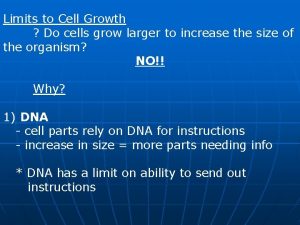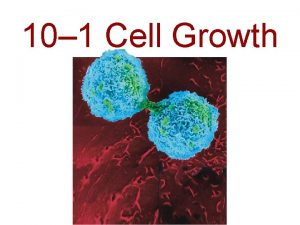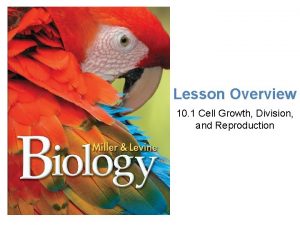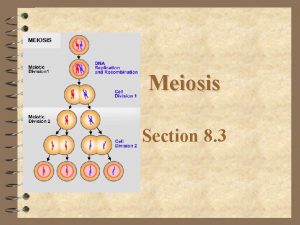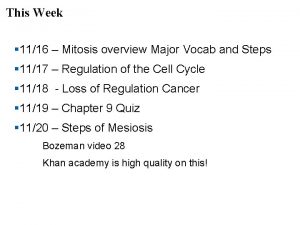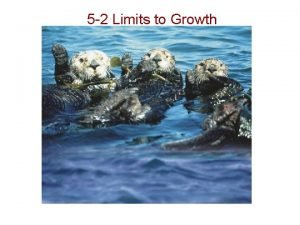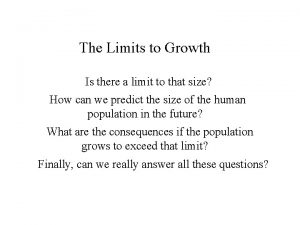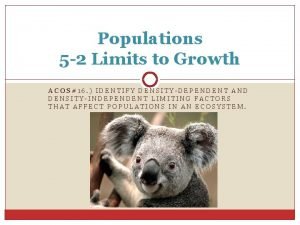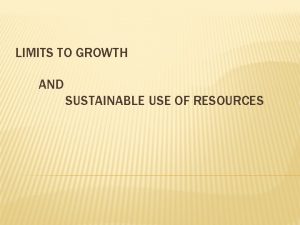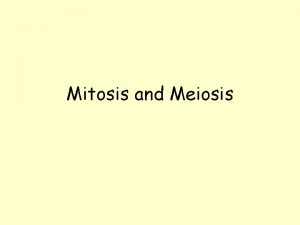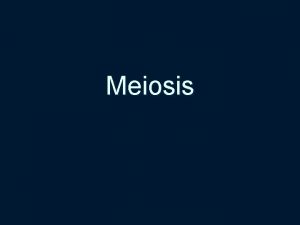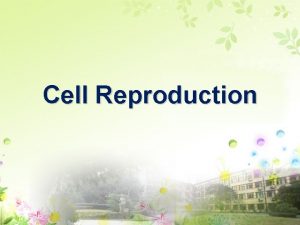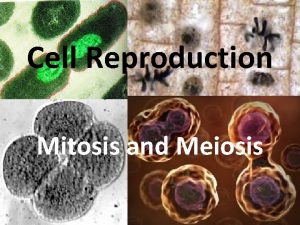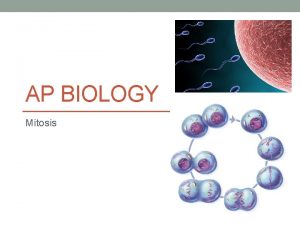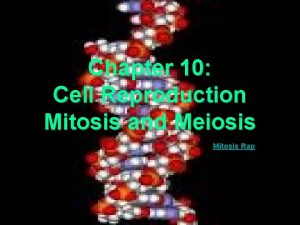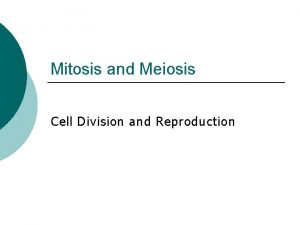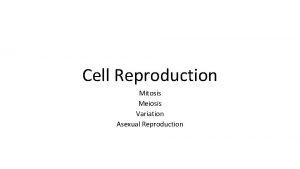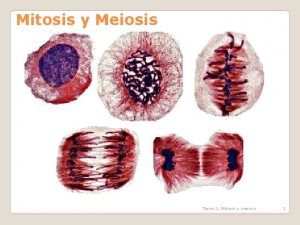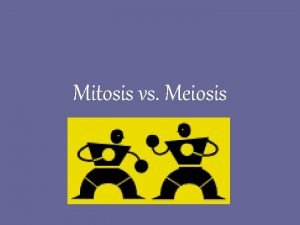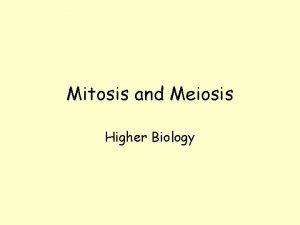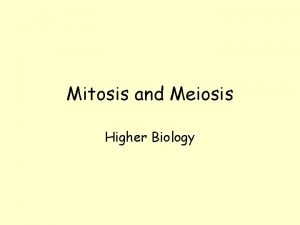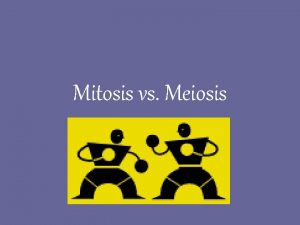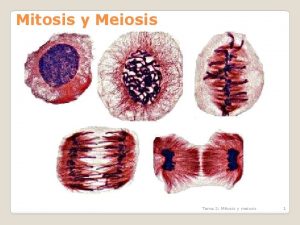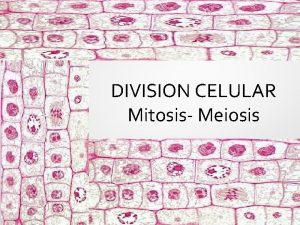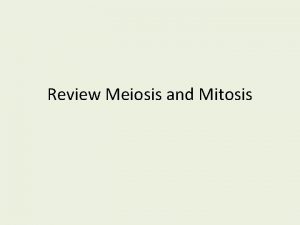Cell Growth Reproduction Mitosis Meiosis Limits to Cell





















- Slides: 21

Cell Growth & Reproduction Mitosis & Meiosis

Limits to Cell Growth l Why does a cell divide instead of growing indefinitely? – – The larger a cell becomes the more demands the cell places on its DNA Trouble moving enough nutrients and wastes across the cell membrane

Fun Facts Cell Growth Rate: If left unchecked E. coli could engulf the Earth in one day because it doubles in volume every 30 minutes Some cells divide more than others Ex. Brain, nerve, heart cells—rarely divide Skin cells—always dividing

Chromosomes l l l Made of DNA and carry the genetic information Each chromosome consists of two identical sister chromatids Each pair of chromatids is attached at the centromere

Why can’t you mate your dog and cat and get a cog or a dat? l Chromosomes must pair up perfectly in organisms in order to successfully produce offspring.

The Number of Chromosomes Differ Depending on the Organism l l Dogs have 78 Cats have 32 Humans have 46 Carrots have 18 l l l Fish have 94 Amoeba have 50 Lettuce has 18

The Cell Cycle The series of events that cells go through as they grow and divide

Five Phases of the Cell Cycle l Interphase – – – l l G 1: Gap 1 S: Synthesis G 2: Gap 2 M: Mitosis C: Cytokinesis

Interphase l l l G 1: cells grow and make more cytoplasm and organelles S: DNA is replicated G 2: all structures needed for division are made (ex. centrioles)

M Phase: Mitosis l l l Division of the nucleus Only occurs in eukaryotes Uncontrolled cell growth leads to cancer

Prophase l l l Cell spends 60% of it’s time here Chromatin condenses and becomes visible Nuclear envelope disappears Centrioles pull apart Spindle forms

Metaphase l l l Shortest phase of replication Chromosomes line up across the center of the cell Microtubules connect the centromere to spindle poles

Anaphase l Centromeres split and sister chromatids are pulled towards opposite poles

Telophase l l l Nuclear membrane reforms around each set of chromosomes Chromosomes uncoil Mitosis is complete!

Cytokinesis l l Division of the cytoplasm into two new cells Two nuclei form Animal Cells: cell membrane is drawn inward (cleavage furrow) until the cytoplasm is pinched into two Plant Cells: cell plate forms and develops into cell wall

Cytokinesis

Meiosis

Important Vocabulary l l Meiosis- a process of reduction division in which the number of chromosomes per cell is cut in half through the separation of homologous chromosomes in a diploid cell Homologous pair: each chromosome that came from mom has a corresponding chromosome that came from dad Diploid(2 N): a cell that contains both sets of homologous chromosomes – (ex. Human body cells— 46) Haploid(N): a cell that contains a single set of chromosomes – (ex. gametes of sexually reproducing organisms/ human egg cell— 23 and human sperm— 23)

Meiosis I l l l Interphase I: DNA Replication Prophase I: each chromosome pairs with its corresponding homologous chromosome to form a tetrad(4) Crossing Over-the exchange of portions of their chromatids Metaphase I: spindle fibers attach to the chromosomes Anaphase I: spindle fibers pull the homologous chromosomes towards opposite ends of the cell Telophase I & Cytokinesis: nuclear membrane forms and the cell separates into two individual cells

Meiosis II l l l No DNA replication The two cells produced by Meiosis I now enter a second meiotic division Prophase II: two haploid(N) daughter cells Metaphase II: chromosomes line up Anaphase II: sister chromatids separate Telophase II & Cytokinesis: results in 4 haploid cells

Gamete Formation l l Spermatogenesis Oogenesis Females undergo meiosis before birth and it immediately stops when you’re born. Hormone levels during puberty cause menstruation with the release of one egg per month for about 25 years. Males do not begin meiosis until puberty.
 Limits to cell growth
Limits to cell growth Limits to cell growth
Limits to cell growth Mitosis meiosis
Mitosis meiosis Two cells are produced
Two cells are produced Concept map: the cell cycle
Concept map: the cell cycle Cell growth division and reproduction
Cell growth division and reproduction Limit involving infinity
Limit involving infinity Real limits statistics
Real limits statistics Sexual reproduction vs asexual reproduction venn diagram
Sexual reproduction vs asexual reproduction venn diagram Hare lynx
Hare lynx Sexual and asexual reproduction in animals venn diagram
Sexual and asexual reproduction in animals venn diagram Is mitosis asexual
Is mitosis asexual Sexual reproduction and genetics section 1 meiosis
Sexual reproduction and genetics section 1 meiosis Chapter 10 section 3 gene linkage and polyploidy
Chapter 10 section 3 gene linkage and polyploidy Section 8-3 meiosis
Section 8-3 meiosis Non kinetochore microtubules
Non kinetochore microtubules Limiting factors example
Limiting factors example Limits to growth
Limits to growth Density independent factors examples
Density independent factors examples Limits to growth
Limits to growth Whats the difference between mitosis and meiosis
Whats the difference between mitosis and meiosis Keslerscience
Keslerscience
